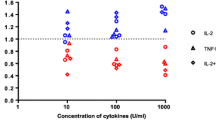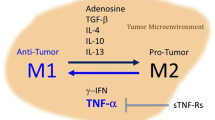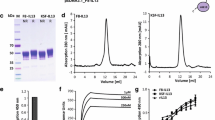Abstract
Interleukin-2 (IL-2) is one of the most successful cytokines applied in tumor immunotherapy because of its ability to stimulate potent cellular immune response. The life-threatening toxicity of vascular leak syndrome (VLS) associated with the high-dose IL-2 treatment regimen has limited its use in tumor immunotherapy. To reverse this situation, a tumor-targeted fusion protein, recombinant human TNT-IL2 (rhTNT-IL2), was generated with both the cytokine activity of IL-2 and the tumor-targeting ability of TNT antibody. TNT is a human tumor necrosis therapy monoclonal antibody capable of binding intracellular antigens which are accessible and abundant in necrotic regions of tumors. The immunotherapeutic potential of this fusion protein was tested in murine melanoma and lung cancer models, and tumor-bearing mice showed satisfied tumor regressions after rhTNT-IL2 immunotherapy. Immunohistochemical study showed a distinct penetration of IL-2 in tumors in mice treated with rhTNT-IL2, indicating its evident tumor-targeting activity. Moreover, the rhTNT-IL2 was well tolerated in cynomolgus monkeys in a 12-week long-term repeated toxicity study. These studies indicate that the targeting of IL-2 to necrotic areas of tumors might be a new approach for the immunotherapy of solid tumors.





Similar content being viewed by others
References
Atkins MB (2006) Cytokine-based therapy and biochemotherapy for advanced melanoma. Clin Cancer Res 12:2353–2358
Atkins MB, Hsu J, Lee S, Cohen GI, Flaherty LE, Sosman JA, Sondak VK, Kirkwood JM, Eastern Cooperative Oncology Group (2008) Phase III trial comparing concurrent biochemotherapy with cisplatin, vinblastine, dacarbazine, interleukin-2, and interferon alfa-2b with cisplatin, vinblastine, and dacarbazine alone in patients with metastatic malignant melanoma (E3695): a trial coordinated by the Eastern Cooperative Oncology Group. J Clin Oncol 26:5748–5754
Baluna R, Rizo J, Gordon BE, Ghetie V, Vitetta ES (1999) Evidence for a structural motif in toxins and interleukin-2 that may be responsible for binding to endothelial cells and initiating vascular leak syndrome. Proc Natl Acad Sci U S A 96:3957–3962
Bebbington CR, Renner G, Thomson S, King D, Abrams D, Yarranton GT (1992) High-level expression of a recombinant antibody from myeloma cells using a glutamine synthetase gene as an amplifiable selectable marker. Biotechnology (N Y) 10:169–175
Carnemolla B, Borsi L, Balza E, Castellani P, Meazza R, Berndt A, Ferrini S, Kosmehl H, Neri D, Zardi L (2002) Enhancement of the antitumor properties of interleukin-2 by its targeted delivery to the tumor blood vessel extracellular matrix. Blood 99:1659–1665
Chapman PB (2008) Combining a peptide vaccine with high-dose interleukin-2. J Clin Oncol 26:2250–2251
Chen S, Yu L, Jiang C, Zhao Y, Sun D, Li S, Liao G, Chen Y, Fu Q, Tao Q, Ye D, Hu P, Khawli LA, Taylor CR, Epstein AL, Ju DW (2005) Pivotal study of iodine-131-labeled chimeric tumor necrosis treatment radioimmunotherapy in patients with advanced lung cancer. J Clin Oncol 23:1538–1547
Epstein AL, Chen FM, Taylor CR (1988) A novel method for the detection of necrotic lesions in human cancers. Cancer Res 48:5842–5848
Gallagher DC, Bhatt RS, Parikh SM, Patel P, Seery V, McDermott DF, Atkins MB, Sukhatme VP (2007) Angiopoietin 2 is a potential mediator of high-dose interleukin 2-induced vascular leak. Clin Cancer Res 13:2115–2120
Gillies SD, Lan Y, Hettmann T, Brunkhorst B, Sun Y, Mueller SO, Lo KM (2011) A low-toxicity IL-2-based immunocytokine retains antitumor activity despite its high degree of IL-2 receptor selectivity. Clin Cancer Res 17:3673–3685
Goldman B, DeFrancesco L (2009) The cancer vaccine roller coaster. Nat Biotechnol 27:129–139
Hoogenboom HR, Winter G (1992) By-passing immunisation. Human antibodies from synthetic repertoires of germlineVH gene segments rearranged in vitro. J Mol Biol 227:381–388
Hornick JL, Sharifi J, Khawli LA, Hu P, Biela BH, Mizokami MM, Yun A, Taylor CR, Epstein AL (1998) A new chemically modified chimeric TNT-3 monoclonal antibody directed against DNA for the radioimmunotherapy of solid tumors. Cancer Biother Radiopharm 13:255–268
Hu P, Hornick JL, Glasky MS, Yun A, Milkie MN, Khawli LA, Anderson PM, Epstein AL (1996) A chimeric Lym-1/interleukin 2 fusion protein for increasing tumor vascular permeability and enhancing antibody uptake. Cancer Res 56:4998–5004
Hu P, Mizokami M, Ruoff G, Khawli LA, Epstein AL (2003) Generation of low-toxicity interleukin-2 fusion proteins devoid of vasopermeability activity. Blood 101:4853–4861
Khawli LA, Hu P, Epstein AL (2005) NHS76/PEP2, a fully human vasopermeability-enhancing agent to increase the uptake and efficacy of cancer chemotherapy. Clin Cancer Res 11:3084–3093
Kirkwood JM, Tarhini AA, Panelli MC, Moschos SJ, Zarour HM, Butterfield LH, Gogas HJ (2008) Next generation of immunotherapy for melanoma. J Clin Oncol 26:3445–3455
Li J, Hu P, Khawli LA, Epstein AL (2003) Complete regression of experimental solid tumors by combination LEC/chTNT-3 immunotherapy and CD25+ T-cell depletion. Cancer Res 63:8384–8392
Liu A, Hu P, Khawli LA, Epstein AL (2006) B7.1/NHS76: a new costimulator fusion protein for the immunotherapy of solid tumors. J Immunother 29:425–435
Lode HN, Reisfeld RA (2000) Targeted cytokines for cancer immunotherapy. Immunol Res 21:279–288
Lotze MT, Frana LW, Sharrow SO, Robb RJ, Rosenberg SA (1985) In vivo administration of purified human interleukin 2. I. Half-life and immunologic effects of the Jurkat cell line-derived interleukin 2. J Immunol 134:157–166
Mårlind J, Kaspar M, Trachsel E, Sommavilla R, Hindle S, Bacci C, Giovannoni L, Neri D (2008) Antibody-mediated delivery of interleukin-2 to the stroma of breast cancer strongly enhances the potency of chemotherapy. Clin Cancer Res 14:6515–6524
McDermott DF (2007) Update on the application of interleukin-2 in the treatment of renal cell carcinoma. Clin Cancer Res 13:716–720
Penichet ML, Morrison SL (2001) Antibody-cytokine fusion proteins for the therapy of cancer. J Immunol Methods 248:91–101
Puskas J, Skrombolas D, Sedlacek A, Lord E, Sullivan M, Frelinger J (2011) Development of an attenuated interleukin-2 fusion protein that can be activated by tumour-expressed proteases. Immunology 133:206–220
Rosenberg SA (2000) Interleukin-2 and the development of immunotherapy for the treatment of patients with cancer. Cancer J Sci Am 6:S2–S7
Sasso EH, Silverman GJ, Mannik M (1991) Human IgA and IgG F(ab’)2 that bind to staphylococcal protein A belong to the VHIII subgroup. J Immunol 147:1877–1883
Schreiber TH, Deyev VV, Rosenblatt JD, Podack ER (2009) Tumor-induced suppression of CTL expansion and subjugation by gp96-Ig vaccination. Cancer Res 69:2026–2033
Sharifi J, Khawli LA, Hu P, King S, Epstein AL (2001) Characterization of a phage display-derived human monoclonal antibody (NHS76) counterpart to chimeric TNT-1 directed against necrotic regions of solid tumors. Hybrid Hybridomics 20:305–312
Silacci M, Brack S, Schirru G, Mårlind J, Ettorre A, Merlo A, Viti F, Neri D (2005) Design, construction, and characterization of a large synthetic human antibody phage display library. Proteomics 5:2340–2350
Sosman JA, Carrillo C, Urba WJ, Flaherty L, Atkins MB, Clark JI, Dutcher J, Margolin KA, Mier J, Gollob J, Kirkwood JM, Panka DJ, Crosby NA, O'Boyle K, LaFleur B, Ernstoff MS (2008) Three phase II cytokine working group trials of gp100 (210 M) peptide plus high-dose interleukin-2 in patients with HLA-A2-positive advanced melanoma. J Clin Oncol 26:2292–2298
van der Vliet HJ, Koon HB, Yue SC, Uzunparmak B, Seery V, Gavin MA, Rudensky AY, Atkins MB, Balk SP, Exley MA (2007) Effects of the administration of high-dose interleukin-2 on immunoregulatory cell subsets in patients with advanced melanoma and renal cell cancer. Clin Cancer Res 13:2100–2108
Wagner K, Schulz P, Scholz A, Wiedenmann B, Menrad A (2008) The targeted immunocytokine L19-IL2 efficiently inhibits the growth of orthotopic pancreatic cancer. Clin Cancer Res 14:4951–4960
Wei S, Kryczek I, Edwards RP, Zou L, Szeliga W, Banerjee M, Cost M, Cheng P, Chang A, Redman B, Herberman RB, Zou W (2007) Interleukin-2 administration alters the CD4+FOXP3+ T-cell pool and tumor trafficking in patients with ovarian carcinoma. Cancer Res 67:7487–7494
Wei S, Shreiner AB, Takeshita N, Wei S, Shreiner AB, Takeshita N, Chen L, Zou W, Chang AE (2008) Tumor-induced immune suppression of in vivo effector T-cell priming is mediated by the B7-H1/PD-1 axis and transforming growth factor beta. Cancer Res 68:5432–5438
Yu L, Ju DW, Chen W, Li T, Xu Z, Jiang C, Chen S, Tao Q, Ye D, Hu P, Khawli LA, Taylor CR, Epstein AL (2006) 131I-chTNT radioimmunotherapy of 43 patients with advanced lung cancer. Cancer Biother Radiopharm 21:5–14
Zuckier LS, Georgescu L, Chang CJ, Scharff MD, Morrison SL (1994) The use of severe combined immunodeficiency mice to study the metabolism of human immunoglobulin G. Cancer 73:794–799
Acknowledgments
This work was supported by Shanghai Science and Technology funds (11431920104), National Science and Technology Major Project for Drug Discovery of the Ministry of Science and Technology of China (2011ZX09102-001-27), and Shanghai Health Bureau funds (2010035). This study was also supported by Shanghai MediPharm Biotech Co. Ltd, Shanghai, China.
Author information
Authors and Affiliations
Corresponding authors
Additional information
Li Ye and Jiajun Fan contributed equally to this work.
Rights and permissions
About this article
Cite this article
Ye, L., Fan, J., Shi, X. et al. Tumor necrosis therapy antibody interleukin-2 fusion protein elicits prolonged and targeted antitumor effects in vivo. Appl Microbiol Biotechnol 98, 4053–4061 (2014). https://doi.org/10.1007/s00253-013-5349-0
Received:
Revised:
Accepted:
Published:
Issue Date:
DOI: https://doi.org/10.1007/s00253-013-5349-0




